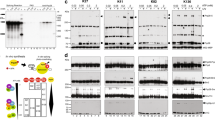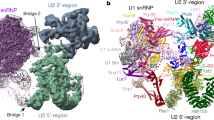Abstract
The spliceosome is a complex ribonucleoprotein (RNP) particle containing five RNAs and more than 100 associated proteins. One of these proteins, PRP8, has been shown to interact directly with the splice sites and branch region of precursor-mRNAs (pre-mRNAs) and spliceosomal RNAs associated with catalysis of the two steps of splicing. The 1.85-Å X-ray structure of the core of PRP8 domain IV, implicated in key spliceosomal interactions, reveals a bipartite structure that includes the presence of an RNase H fold linked to a five-helix assembly. Analysis of mutant yeast alleles and cross-linking results in the context of this structure, coupled with RNA binding studies, suggests that domain IV forms a surface that interacts directly with the RNA structures at the catalytic core of the spliceosome.
This is a preview of subscription content, access via your institution
Access options
Subscribe to this journal
Receive 12 print issues and online access
$189.00 per year
only $15.75 per issue
Buy this article
- Purchase on Springer Link
- Instant access to full article PDF
Prices may be subject to local taxes which are calculated during checkout





Similar content being viewed by others
Accession codes
References
Krämer, A. The structure and function of proteins involved in mammalian pre-mRNA splicing. Annu. Rev. Biochem. 65, 367–409 (1996).
Staley, J.P. & Guthrie, C. Mechanical devices of the spliceosome: motors, clocks, springs, and things. Cell 92, 315–326 (1998).
Burge, C.B., Tuschl, T. & Sharp, P.A. in The RNA World 2nd edn. (eds. Gesteland, R.F., Cech, T.R. & Atkins, J.F.) 525—560 (Cold Spring Harbor Laboratory Press, Cold Spring Harbor, New York, 1999).
Brow, D.A. Allosteric cascade of spliceosome activation. Annu. Rev. Genet. 36, 333–360 (2002).
Valadkhan, S., Mohammadi, A., Wachtel, C. & Manley, J.L. Protein-free spliceosomal snRNAs catalyze a reaction that resembles the first step of splicing. RNA 13, 2300–2311 (2007).
Collins, C.A. & Guthrie, C. The question remains: is the spliceosome a ribozyme? Nat. Struct. Biol. 7, 850–854 (2000).
Reyes, J.L., Gustafson, E.H., Luo, H.R., Moore, M.J. & Konarska, M.M. The C-terminal region of hPrp8 interacts with the conserved GU dinucleotide at the 5′ splice site. RNA 5, 167–179 (1999).
Vidal, V.P., Verdone, L., Mayes, A.E. & Beggs, J.D. Characterization of U6 snRNA-protein interactions. RNA 5, 1470–1481 (1999).
Grainger, R.J. & Beggs, J.D. Prp8 protein: at the heart of the spliceosome. RNA 11, 533–557 (2005).
Teigelkamp, S., Newman, A.J. & Beggs, J.D. Extensive interactions of PRP8 protein with the 5′ and 3′ splice sites during splicing suggest a role in stabilization of exon alignment by U5 snRNA. EMBO J. 14, 2602–2612 (1995).
MacMillan, A.M. et al. Dynamic association of proteins with the pre-mRNA branch region. Genes Dev. 8, 3008–3020 (1994).
Pena, V., Liu, S., Bujnicki, J.M., Luhrmann, R. & Wahl, M.C. Structure of a multipartite protein-protein interaction domain in splicing factor Prp8 and its link to retinitis pigmentosa. Mol. Cell 25, 615–624 (2007).
Query, C.C. & Konarska, M.M. Suppression of multiple substrate mutations by spliceosomal prp8 alleles suggests functional correlations with ribosomal ambiguity mutants. Mol. Cell 14, 343–354 (2004).
Kuhn, A.N., Li, Z. & Brow, D.A. Splicing factor Prp8 governs U4/U6 RNA unwinding during activation of the spliceosome. Mol. Cell 3, 65–75 (1999).
Collins, C.A. & Guthrie, C. Allele-specific genetic interactions between Prp8 and RNA active site residues suggest a function for Prp8 at the catalytic core of the spliceosome. Genes Dev. 13, 1970–1982 (1999).
Turner, I.A., Norman, C.M., Churcher, M.J. & Newman, A.J. Dissection of Prp8 protein defines multiple interactions with crucial RNA sequences in the catalytic core of the spliceosome. RNA 12, 375–386 (2006).
Kuhn, A.N., Reichl, E.M. & Brow, D.A. Distinct domains of splicing factor Prp8 mediate different aspects of spliceosome activation. Proc. Natl. Acad. Sci. USA 99, 9145–9149 (2002).
Yang, K., Zhang, L., Xu, T., Heroux, A. & Zhao, R. Crystal structure of the β-finger domain of Prp8 reveals analogy to ribosomal proteins. Proc. Natl. Acad. Sci. USA 105, 13817–13822 (2008).
Umen, J.G. & Guthrie, C. A novel role for a U5 snRNP protein in 3′ splice site selection. Genes Dev. 9, 855–868 (1995).
Song, J.J., Smith, S.K., Hannon, G.J. & Joshua-Tor, L. Crystal structure of Argonaute and its implications for RISC slicer activity. Science 305, 1434–1437 (2004).
Nowotny, M., Gaidamakov, S.A., Crouch, R.J. & Yang, W. Crystal structures of RNase H bound to an RNA/DNA hybrid: substrate specificity and metal-dependent catalysis. Cell 121, 1005–1016 (2005).
Steiniger-White, M., Rayment, I. & Reznikoff, W.S. Structure/function insights into Tn5 transposition. Curr. Opin. Struct. Biol. 14, 50–57 (2004).
Rupert, P.B. & Ferre-D'Amare, A.R. Crystal structure of a hairpin ribozyme-inhibitor complex with implications for catalysis. Nature 410, 780–786 (2001).
Sashital, D.G., Cornilescu, G. & Butcher, S.E. U2–U6 RNA folding reveals a group II intron-like domain and a four-helix junction. Nat. Struct. Mol. Biol. 11, 1237–1242 (2004).
Nissen, P., Hansen, J., Ban, N., Moore, P.B. & Steitz, T.A. The structural basis of ribosome activity in peptide bond synthesis. Science 289, 920–930 (2000).
Doherty, E.A. & Doudna, J.A. Ribozyme structures and mechanisms. Annu. Rev. Biochem. 69, 597–615 (2000).
Otwinowski, Z. & Minor, W. Processing of X-ray diffraction data collected in oscillation mode. Methods Enzymol. 276, 307–326 (1997).
Terwilliger, T.C. & Berendzen, J. Automated MAD and MIR structure solution. Acta Crystallogr. D Biol. Crystallogr. 55, 849–861 (1999).
Terwilliger, T.C. Maximum-likelihood density modification. Acta Crystallogr. D Biol. Crystallogr. 56, 965–972 (2000).
Terwilliger, T.C. Automated main-chain model-building by template-matching and iterative fragment extension. Acta Crystallogr. D Biol. Crystallogr. 59, 38–44 (2002).
Murshudov, G.N., Vagin, A.A. & Dodson, E.J. Refinement of macromolecular structures by the maximum-likelihood method. Acta Crystallogr. D Biol. Crystallogr. 53, 240–255 (1997).
McRee, D.E. XtalView/Xfit: a versatile program for manipulating atomic coordinates and electron density. J. Struct. Biol. 125, 156–165 (1999).
Brenner, T.J. & Guthrie, C. Genetic analysis reveals a role for the C-terminus of the S. cerevisiae GTPase Snu114 during spliceosome activation. Genetics 170, 1063–1080 (2005).
Acknowledgements
We thank C. Guthrie (University of California, San Francisco) for providing yeast strain YTB72 and the plasmid pJU186MAS, B. Hazes for technical assistance, and M. Glover and T. Wu for helpful discussions. This work was supported by an Operating Grant from the Canadian Institutes of Health Research (CIHR) and by funding from the Alberta Synchrotron Institute.
Author information
Authors and Affiliations
Corresponding author
Supplementary information
Supplementary Text and Figures
Supplementary Figures 1 and 2, Supplementary Methods and Supplementary Discussion (PDF 1090 kb)
Rights and permissions
About this article
Cite this article
Ritchie, D., Schellenberg, M., Gesner, E. et al. Structural elucidation of a PRP8 core domain from the heart of the spliceosome. Nat Struct Mol Biol 15, 1199–1205 (2008). https://doi.org/10.1038/nsmb.1505
Received:
Accepted:
Published:
Issue Date:
DOI: https://doi.org/10.1038/nsmb.1505
This article is cited by
-
Cryo-electron microscopy snapshots of the spliceosome: structural insights into a dynamic ribonucleoprotein machine
Nature Structural & Molecular Biology (2017)
-
Crystal structure of Prp8 reveals active site cavity of the spliceosome
Nature (2013)
-
Spliceosome's core exposed
Nature (2013)
-
Toggling in the spliceosome
Nature Structural & Molecular Biology (2013)
-
A conformational switch in PRP8 mediates metal ion coordination that promotes pre-mRNA exon ligation
Nature Structural & Molecular Biology (2013)



